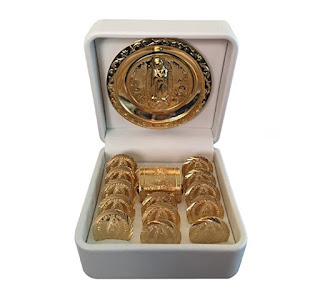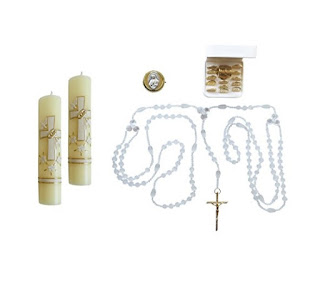Greek weddings are known for huge guest lists, plate smashing, and Greek foods including Baklava, so I thought it would be fun to look at a typical ancient Greek wedding day. I'll start by saying that in ancient Greece, the
wedding ceremony was considered a decisive coming-of-age rite with the
marriageable age for girls ranging from 12-15 years (men were 25-30).
To narrow the focus, what we will look at today are the customs included in the wedding
festivities back then that in some ways reflect our own modern customs.
Ancient Greek wedding feast
In ancient Greece, every wedding included a feast. It provided a bountiful amount of meat often supplied by the prenuptial sacrifices. Friends and family of both the bride and groom feasted together in a ritual sense of community, but men and women sat on opposite sides of the room.
In Euangelos’ play the Anakalyptomene, we get an idea of just how ostentatious the food displayed might have been. In his depiction, the feast included veal, pork, hare, custards cheese, pastries, lydian treats, eggs cake, and while foods did vary from one region to another, there was one traditional food offered at every Greek wedding called “sesame.” It was made from ground sesame seeds mixed with honey and formed into cakes. This custom was tied to fertility. The belief was that the prolific nature of the sesame seed could somehow be transmitted to the new couple.
Ancient Greek bridal customs
- Ancient Greek bridal fashion included loosely draped gowns gathered at
the waist and touching the floor. Form-fitting bridal gowns suggested the
sensuality of their gods and today the elegant goddess gown continues to be a popular choice.
- Ancient Greek brides also wore veils of yellow or red. These colors represented fire and were thought to scare away evil spirits. Today brides most often wear white which is thought to symbolize purity.
- In Ancient Greece, the brides also wore diamonds. In that culture they were considered teardrops of the gods,
reflecting the “flames of love.”
- Ancient Greek brides brides carried or wore flower garlands because they believed flowers signified new beginnings, fidelity and hope of fertility.
Wedding guest list
Like modern-day Greek weddings, the ancients also invited friends and relatives of the bride and groom to the celebration. At that time, men and woman didn’t gather together publicly in the same place but weddings were different. The men and women were allowed to assemble in the same room, but as I mentioned above the men sat on one side and the women on the other. So the brides and grooms of ancient Greece basically had the same problem of deciding who to include on the guest list. In ancient Athens, they tried to curb this problem through legislation that limited the number of guests to 30. Even with this restriction, it was common-place to find freeloaders trying to take advantage of the abundant food.
Wedding venue
Ancient Greek weddings were often held in the home of
one of the families--either the father of the bride or the groom, but in most cases the two families collaborated. However, weddings didn’t always take place in the home. The wedding depicted in Menander’s Dyskolos took place in the shrine of Pan. Today evidence from inscriptions reveal this happened in real life too. In a 300 B.C inscription from Cos, there is evidence that weddings were held in cult sanctuaries. In this particular case, the wedding took place in the sanctuary of Herakles Dionmdonteios. However, not just anyone could use a sanctuary because use was only available to members of the group who oversaw and cared for the facility. And with the use of a sanctuary there were rules. In this particular case, the wedding had to take place in the same month in which they celebrated a festival to Herakles and then the wedding could use part of the meat of the festival sacrifices as part of the feast. However, Herakle had to be present at the celebration in the form of a statue, and he also had to have his own dining couch.

Dancing
and wedding processions
Today when we say “wedding dance” we would probably
think of the father of the bride dancing with his daughter and the groom dancing
with his mother, or even the bride and groom’s first dance as husband and wife.
However, in ancient Greece, dances accompanied all the stages of the ceremony.
This included young men whirling in dance as the bride was led through the city
in the wedding procession. Yes, a wedding procession was a formal part of the
wedding day and it included flutes, cymbals and songs. Sometimes the groom took
part in the procession but not always. Other times, the bride was brought to
the bridal chamber to meet the groom there.
Another procession followed the wedding as the bride
was ushered back to the groom’s house. While we might look at these processions
as tradition, the ancient Greeks’ thought them to be divine in nature and
involving a combination of gods and heroes. I might have to write a post on
this topic alone as it is quite involved.
The last custom I’ll mention here is that of pelting
the bride and groom with leaves and blossoms which was another fertility
custom. In what I found in my research, it looks like the modern-day Greek’s
might still throw rice. Much of what we can learn about ancient Greek weddings
is depicted on vases from that time. To learn more specifics about ancient
weddings in Greece check out The
Nuptial Ceremony of Ancient Greece and the Articulation of Male Control Through
Ritual.
***
Some links in this post are affiliate links. We are a participant in
the Amazon Services LLC Associates Program, an affiliate advertising program
designed to provide a means for us to earn fees by linking to amazon.com and
affiliate sites.
Thanks so much for being part of our success.
Resource: The Wedding in Ancient Athens, By John Howard Oakley, Rebecca H. Sinos
















